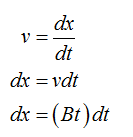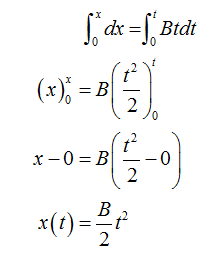If the acceleration, a(t), is given, integration can be used to derive v(t) and x(t). The follwing example is a case where the acceleration is a constant, does not change with time. Example: The car traveles on the x axis with an acceleration of a=B where B isa postive constant. At ti=0 seconds, x=0 meters and v=0 meters/s. Answer Questions 4 and 5 Please, Questions 1-3 have already been resolved. 1) Graph a(t) versus t 2) Find the equation for v(t) 3) Graph v(t) versus t 4) Now find the equation for x(t) versus t 5) Graph x(t) versus t
Displacement, Velocity and Acceleration
In classical mechanics, kinematics deals with the motion of a particle. It deals only with the position, velocity, acceleration, and displacement of a particle. It has no concern about the source of motion.
Linear Displacement
The term "displacement" refers to when something shifts away from its original "location," and "linear" refers to a straight line. As a result, “Linear Displacement” can be described as the movement of an object in a straight line along a single axis, for example, from side to side or up and down. Non-contact sensors such as LVDTs and other linear location sensors can calculate linear displacement. Non-contact sensors such as LVDTs and other linear location sensors can calculate linear displacement. Linear displacement is usually measured in millimeters or inches and may be positive or negative.
If the acceleration, a(t), is given, integration can be used to derive v(t) and x(t). The follwing example is a case where the acceleration is a constant, does not change with time.
Example: The car traveles on the x axis with an acceleration of a=B where B isa postive constant. At ti=0 seconds, x=0 meters and v=0 meters/s.
Answer Questions 4 and 5 Please, Questions 1-3 have already been resolved.
1) Graph a(t) versus t
2) Find the equation for v(t)
3) Graph v(t) versus t
4) Now find the equation for x(t) versus t
5) Graph x(t) versus t
(4)
The first kinematic equation for the car is

Here, u is the initial velocity of the car, a is the acceleration of the car and v is the velocity of the car at time t.
Substitute the known values.

The expression for instantaneous velocity of the car is

Integrate the above relation within the condition of motion.

Step by step
Solved in 2 steps with 5 images









